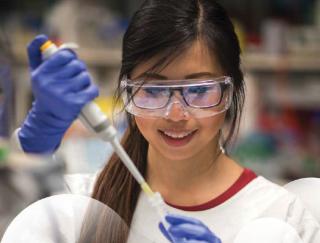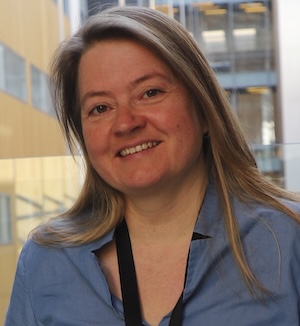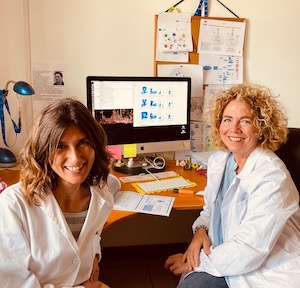Research
 A-T is considered an orphan disease because the pharmaceutical companies have not “adopted” it due to its rarity. Parent-driven associations worldwide have been instrumental in raising funds and engaging with scientists to develop new approaches to combat this disease.
A-T is considered an orphan disease because the pharmaceutical companies have not “adopted” it due to its rarity. Parent-driven associations worldwide have been instrumental in raising funds and engaging with scientists to develop new approaches to combat this disease.
Research into possible treatments for A-T may offer exciting implications beyond the relatively small A-T community. Advancements in the understanding of the ATM protein may provide insight into, and treatments for, other neuro-degenerative conditions such as Alzheimer’s, Parkinson’s disease and Multiple Sclerosis, as well as metabolic syndromes, cardiovascular disease, respiratory disease, cancer and immunodeficiency diseases such as AIDS.
BrAshA-T aims to support ground-breaking research around the world, and we are very fortunate to have two dedicated and highly talented A-T research teams in our home city of Brisbane, Australia who are working on a cure for A-T:
Professor Martin Lavin
 The major focus of Professor Martin Lavin’s research at UQCCR (University of Queensland Centre for Clinical Research) has been on the importance of DNA damage response in minimising genetic instability and cancer.
The major focus of Professor Martin Lavin’s research at UQCCR (University of Queensland Centre for Clinical Research) has been on the importance of DNA damage response in minimising genetic instability and cancer.
Professor Lavin has established an international reputation for his work on A-T and regularly meets with international researchers to share their findings and insights into A-T. Professor Lavin is working tirelessly towards repairing the genetic mutation that causes A-T using gene therapy. His success could have far reaching implications and see this science applied to all genetic disorders.
Click here for more information about the work being undertaken by Martin and his team.
Professor Ernst Wolvetang 
Professor Ernst Wolvetang from the AIBN (Australian Institute for Bioengineering and Nanotechnology) is leading the derivation of footprint-free induced pluripotent stem cells (iPSC) in Australia, with a particular focus on neuronal and cardiac disease models.
It is hoped that his work will one day enable the cerebellum of A-T patients to be repaired using iPSC, reversing the neurodegeneration in A-T patients. Scientists in Japan have already applied this knowledge to successfully reversing macular degeneration.
Click here for more details of the work undertaken by Ernst and his team.
Unique Opportunity for Researchers, Clinicians and Families
Professor Lavin, Professor Wolvetang and other scientists engaged in A-T research regularly meet with the A-T children and their families during the clinics held throughout the year, updating them on their progress. This has resulted in a unique relationship between the researchers and the families, and a personal commitment, passion and urgency to find a cure in time to save these precious kids. BrAshA-T and our invaluable researchers strongly believe that it is not a matter of if, but when, we will find a cure.
A Collaborative Global Approach
We are a founding member of the A-T Global Alliance which was established in 2020 to maximise the effort, resources and funding committed to finding a cure or treatments for A-T.
 A-T doesn’t discriminate and neither do the discoveries. They benefit people everywhere, regardless of where they were made. By bringing together universities, researchers, clinicians and Charities, the A-T Global Alliance has established hubs of research in cities all around the globe. This research network allows the smartest minds to work together, to ensure discoveries are turned into benefits for people with A-T everywhere, sooner.
A-T doesn’t discriminate and neither do the discoveries. They benefit people everywhere, regardless of where they were made. By bringing together universities, researchers, clinicians and Charities, the A-T Global Alliance has established hubs of research in cities all around the globe. This research network allows the smartest minds to work together, to ensure discoveries are turned into benefits for people with A-T everywhere, sooner.
Through the web site, cureat.org, the alliance also created a Global Directory which provides useful information (e.g. care guides, the latest research studies and publications) for patients and their families, researchers and clinicians.
Spotlight on A-T
The members of the A-T Alliance were delighted to stage another family focussed Spotlight on A-T webinar on the 27 March 2023. The event was hosted by broadcaster and journalist Naga Munchetty and Dr Mark Toms and presentations were given by various speakers from the international A-T research community.
We were joined by A-T families, clinicians and researchers from the USA, Italy, Spain, France, Australia, UK and many other countries around the world who submitted questions to a variety of researchers and clinicians as well as providing feedback and taking part in online polls. The webinar was recorded and is available to view below.
Alliance Co-Funded Studies
Here are the latest alliance studies to which we have made a significant investment:
Preclinical Assessment of Intrathecal rAAV9-Mediated miATM Therapy for A-T in Mouse Models
 Initiated in Spain in early 2024, and jointly funded by AEFAT (Spain), Action for A-T (UK) and BrAshA-T (Australia), this study is led by researcher Hilde L. Nilsen, from the Department of Microbiology, Genomic Instability in Aging and Disease at Oslo University Hospital (OUH) in Norway.
Initiated in Spain in early 2024, and jointly funded by AEFAT (Spain), Action for A-T (UK) and BrAshA-T (Australia), this study is led by researcher Hilde L. Nilsen, from the Department of Microbiology, Genomic Instability in Aging and Disease at Oslo University Hospital (OUH) in Norway.
The three A-T Alliance organisations have joined forces to fund the $250,000, 18-24 month project which will be managed by AEFAT.
The project will prepare for trials with animal models, aiming to propose a potential international clinical trial in humans in the coming years. This research has the potential to transform classic ataxia telangiectasia into a milder form of the disease.
Read more here (scroll down the linked web page for English version).
Modelling A-T Pathogenesis and Therapeutics using Human Pluripotent Stem Cells and Genetic Engineering
Initiated in Spain in early 2024, and jointly funded by AEFAT (Spain), Action for A-T (UK) and BrAshA-T (Australia), this study is led by researcher Núria Montserrat Pulido, from the Institute for Bioengineering of Catalonia (IBEC, Barcelona).
The three A-T Alliance organisations have joined forces to fund the $250,000, 18-24 month project which will be managed by AEFAT.
Genetic and cell engineering will be used to generate iPSc cells with causal mutations of A-T and, on the other hand, generate different types of cells and tissues affected in these patients.
Cultures, called organoids, are cellular systems that can be generated in the laboratory that resemble the organ to be studied with a view to creating a platform for drug testing.
Read more here (scroll down the linked web page for English version).
Understanding and correcting glucose metabolism defects in A-T
 We are delighted to announce the commencement on the 1st of April 2023 of the 5th and final study from the 2022 Alliance Grant Round at IFOM (The FIRC Institute of Molecular Oncology) in Milan, Italy, in partnership with Action for A-T (UK), The A-T Society (UK), BrAshA-T (Australia) and AEFAT (Spain).
We are delighted to announce the commencement on the 1st of April 2023 of the 5th and final study from the 2022 Alliance Grant Round at IFOM (The FIRC Institute of Molecular Oncology) in Milan, Italy, in partnership with Action for A-T (UK), The A-T Society (UK), BrAshA-T (Australia) and AEFAT (Spain).
The four A-T Alliance organisations have joined forces to fund the $235,000, 36-month project which will be managed by Action for A-T. The project led by Associate Professor Vincenzo Costanzo, will test the hypothesis that ATM (the protein which is missing or not functioning completely in A-T) controls chemical reactions required for the correct use of glucose.
Glucose usage defects could lead to glycogen accumulation which might be toxic for brain cells.
Read more here.
Digital drug prediction informed by genetic analysis of stem cell-derived mini-brains from A-T patients
 We are delighted to be supporting a new A-T research study at QIMR Berghofer Medical Research Institute (Australia), in partnership with Action for A-T (UK), The A-T Society (UK), BrAshA-T (Australia) and AEFAT (Spain).
We are delighted to be supporting a new A-T research study at QIMR Berghofer Medical Research Institute (Australia), in partnership with Action for A-T (UK), The A-T Society (UK), BrAshA-T (Australia) and AEFAT (Spain).
The four A-T Alliance organisations have joined forces to fund the $270,000 36-month project which will be managed by Action for A-T. The project led by Dr Sam Nayler, aims to uncover how specific cell types are affected in A-T and build a model that has discovery and pre-clinical testing capability.
Read more here.
Trial REadiness in A-T (TREAT-AT)
 We are delighted to be supporting a new A-T research study at the University of Cambridge (UK), in partnership with Action for A-T (UK), The A-T Society (UK), BrAshA-T (Australia) and AEFAT (Spain).
We are delighted to be supporting a new A-T research study at the University of Cambridge (UK), in partnership with Action for A-T (UK), The A-T Society (UK), BrAshA-T (Australia) and AEFAT (Spain).
The four A-T Alliance organisations have joined forces to fund the 36-month $450,000 project which will be managed by Action for A-T.
The project entitled Trial REadiness in Ataxia Telangiectasia (TREAT-AT) led by Dr Rita Horvath and Dr Anke Hensiek will study the clinical symptoms, blood biomarkers and brain imaging findings in a subgroup of A-T caused by the so called “UK mutation”.
Read more here.
Study of Natural Killer Cells in A-T
 We are delighted to be supporting a new A-T research study at the Bambino Gesù Children’s Hospital (Rome, Italy), in partnership with Action for A-T (UK), The A-T Society (UK), BrAshA-T (Australia) and AEFAT (Spain).
We are delighted to be supporting a new A-T research study at the Bambino Gesù Children’s Hospital (Rome, Italy), in partnership with Action for A-T (UK), The A-T Society (UK), BrAshA-T (Australia) and AEFAT (Spain).
The four A-T Alliance organisations have joined forces to fund the 24-month $165,000 project which will be managed by Action for A-T.
The project entitled Study of natural killer cells in A-T pathogenesis and their therapeutic implications led by Dr Margherita Doria (pictured on the right) and Dr. Maria Giovanna Desimio, will endeavour to develop predictive cancer tests, and provide an important building block for the design of innovative strategies to lengthen and improve lives.
Read more here.
Brain-penetrating ATM gene therapy
 We are delighted to be supporting a new A-T research study at the University of Nottingham in partnership with Action for A-T (UK), The A-T Society (UK), BrAshA-T (Australia) and AEFAT (Spain).
We are delighted to be supporting a new A-T research study at the University of Nottingham in partnership with Action for A-T (UK), The A-T Society (UK), BrAshA-T (Australia) and AEFAT (Spain).
The four A-T Alliance organisations have joined forces to fund the 24-month $260,000 project which will be managed by Action for A-T.
The project entitled Brain-penetrating ATM gene therapy led by Dr James Dixon, will endeavour to combine gene therapy and editing to engineer an effective therapy to treat A-T in the brain.
Read more here.
